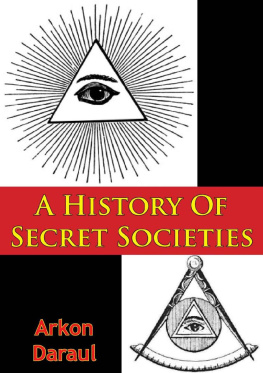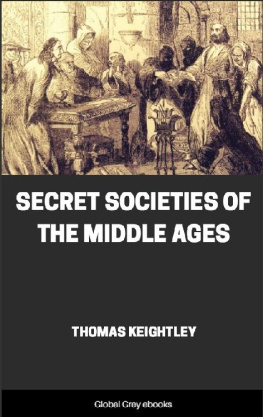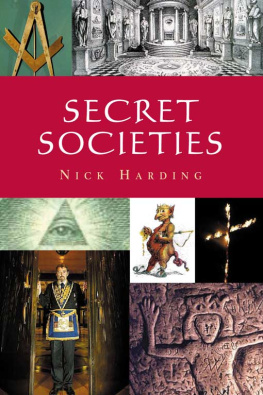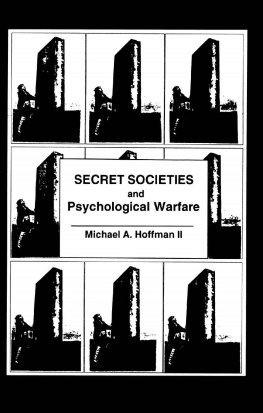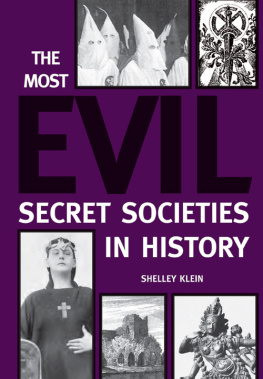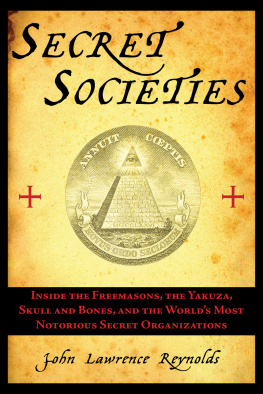Arkon Daraul [Daraul - A History Of Secret Societies
Here you can read online Arkon Daraul [Daraul - A History Of Secret Societies full text of the book (entire story) in english for free. Download pdf and epub, get meaning, cover and reviews about this ebook. year: 2015, publisher: Normanby Press, genre: Religion. Description of the work, (preface) as well as reviews are available. Best literature library LitArk.com created for fans of good reading and offers a wide selection of genres:
Romance novel
Science fiction
Adventure
Detective
Science
History
Home and family
Prose
Art
Politics
Computer
Non-fiction
Religion
Business
Children
Humor
Choose a favorite category and find really read worthwhile books. Enjoy immersion in the world of imagination, feel the emotions of the characters or learn something new for yourself, make an fascinating discovery.
- Book:A History Of Secret Societies
- Author:
- Publisher:Normanby Press
- Genre:
- Year:2015
- Rating:5 / 5
- Favourites:Add to favourites
- Your mark:
- 100
- 1
- 2
- 3
- 4
- 5
A History Of Secret Societies: summary, description and annotation
We offer to read an annotation, description, summary or preface (depends on what the author of the book "A History Of Secret Societies" wrote himself). If you haven't found the necessary information about the book — write in the comments, we will try to find it.
Arkon Daraul [Daraul: author's other books
Who wrote A History Of Secret Societies? Find out the surname, the name of the author of the book and a list of all author's works by series.
A History Of Secret Societies — read online for free the complete book (whole text) full work
Below is the text of the book, divided by pages. System saving the place of the last page read, allows you to conveniently read the book "A History Of Secret Societies" online for free, without having to search again every time where you left off. Put a bookmark, and you can go to the page where you finished reading at any time.
Font size:
Interval:
Bookmark:

This edition is published by PICKLE PARTNERS PUBLISHINGwww.picklepartnerspublishing.com
To join our mailing list for new titles or for issues with our books picklepublishing@gmail.com
Or on Facebook
Text originally published in 1962 under the same title.
Pickle Partners Publishing 2015, all rights reserved. No part of this publication may be reproduced, stored in a retrieval system or transmitted by any means, electrical, mechanical or otherwise without the written permission of the copyright holder.
Publishers Note
Although in most cases we have retained the Authors original spelling and grammar to authentically reproduce the work of the Author and the original intent of such material, some additional notes and clarifications have been added for the modern readers benefit.
We have also made every effort to include all maps and illustrations of the original edition the limitations of formatting do not allow of including larger maps, we will upload as many of these maps as possible.
A HISTORY OF SECRET SOCIETIES
BY
ARKON DARAUL

Contents
Assyrian Tree of Life design
Philip the Fair
The original Seal of the Templars
The last Grand Master of the Templars
Latter-day Templar seal
Cyphers used by secret societies
Detail from a Moslem coat-of-arms
Symbol of Power of Gnostic Society
Altar of a Western secret society
Secret cyphers
Cyphers used by secret societies
Cyphers used by secret societies
Seal of the Holy Vehm
Chinese secret society seal
Bamboo summons to Tong member
Fig.
A. Assassins: (i) Document seal; (ii) Initiates mark; (iii) Chiefs symbol; (iv) Seal on Order to Kill
B. Assassins: badge of the Order
C. Sufi Tree of Life emblem meaning Wisdom
D. Contemporary Mithra-cult: (i) Sign of Member; (ii) Sign for temple; (iii) Important meeting; (iv) Concentration symbol; (v) Consecration symbol; (vi) Official seal
E. Skoptsi Cult; (i) Initiates mark; (ii) Danger signal; (iii) Members house-mark
F. Yezidi emblem used as power talisman
G. Yezidis: recognition signals, made with the hands: (i) Degree of Disciple; (ii) Degree of Ecstatic; (iii) Degree of Priest; (iv) Degree of Sheikh
H. Thugs: hand signals: (i) All clear, all safe; (ii) Do not attack this person; (iii) I want to talk to you privately; (iv) Kill; (v) Tonight; (vi) There is a meeting; (vii) Homage to Kali; (viii) I am a member; (ix) I am a Priest; (x) Be silent
I. Path of the Rose Society: identification emblem
J. Roshaniyya emblem meaning Light
ALMOST everyone who has written about secret societies has attempted a definition of what such a society is: yet no satisfactory description of the phenomenon has yet been attained. This is because there are so many variants surrounding the central fact of the existence of the society that what will identify one society will not fit another.
Not all secret societies are entirely secret: many of their members may be known (as in the case of the Freemasons); their objectives (as with the Rosicrucians) may be stated publicly; their teachings (as those of the Assassins) may be available to all. The secrecy of the society is not always confined to the few. In most primitive tribal initiations (which exactly resemble many civilized secret societies) all the adults are members. This latter fact means that the society is working not against established authority, but for it, removing the validity of the argument that all secret associations are dedicated to the destruction of properly constituted authority.
It is interesting to note how students of this strange branch of human activity have tended to miss the fact that the secret society is an amalgam of many elements which are found in ordinary life. There is the exclusivity of membership, the importance attaching to being a member. This is found in clubs and associations which are not in any way secret: found among thousands of coteries of individuals everywhere and in all eras. Then there is the use of signs, passwords and similar materials. These, too, perform a function in human organization everywhere. Thirdly, there is the objective of the society. This may be almost anything, and is found in all manner of pressure-groups wherever humanity congregates.
There is the shared experience of the rituals and the belief (the myth) of the society. Every clan, nation, even family has such myths and rituals, which come to have a special meaning for the participants.
These are some of the materials for the secret society. The uniqueness of the true secret society is that certain aspects of human thought which are particularly compelling are combined to train and maintain the efforts of a group of people to operate in a certain direction.
It is the undesirable activities of some secret societies and their very air of mystery which has given them the reputation of being strange, abnormal associations. When, however, their beliefs become those of the majority, they cease to be considered anti-social. It is as simple as that.
The secret organizations dealt with in this book have been chosen in such a way as to illustrate the widest variety of their forms, rituals and beliefs. Much of the material has been obtained at first-hand and is published for the first time.
Secret societies are generally considered to be anti-social: to contain elements which are distasteful or harmful to the community at large. Such is undoubtedly the casesometimes. Communism and Fascism function as secret societies in countries where they are prohibited by law. Christianity was a secret society in Rome, and was considered by the authorities from the start to be a dangerous innovation. The same was true of Islam. It can be said that at least some of the believers in these creeds, working in secret, were genuinely devout believers that what they practised was for the eventual good of society. The Arabs today consider that the Jews constitute a dangerous secret society which is dedicated to the overwhelming of the world. The Druses and Yezidis in Syria and Iraq think the same of the Arabs. Freemasons and Catholics hold almost precisely similar ideas about each other. It is impossible, incidentally, to divorce the study of secret societies from religion, because even avowedly criminal societies so often have religious origins or pretensions. If one takes the position that social right and wrong should be the mentor in estimating the value of the secret society, a stumbling-block of similar magnitude appears. In Borneo, initiates of the hunting societies considered it meritorious and necessary to hunt heads. In Polynesia, infanticide and debauch were considered essential for initiation into societies where the tribal code needed members who indulged in these things, as pillars of society. In Africa, North America, Melanesia and elsewhere, initiation into the highest degrees of clan life (and consequent status as a man and a just man at that) involved undergoing trials which not infrequently resulted in the death or madness of the candidate.
Since the earliest recorded times, the official administration of any given country has been concerned with maintaining the status quo and defending society as constituted against minority groups which sought to function as states within states, or to overthrow the authority of the time. Few of such efforts have been permanently successful, and it seems unlikely from the sociological point of view that they ever will be. The human desire to be one of the elect is something which no power has yet been able to reduce, let alone overcome. Whether this is a good or a bad thing depends entirely upon ones point of view and ones commitments at the time of judging the question. This book does not pretend to be an exhaustive account of secret societies: none such has ever been nor ever will be written. But in these pages will be found some of the characteristic forms which secret societies and cults have takensuccessfully and otherwise. None of them can be regarded as good from every point of view. But all of them can be considered evil, from one standpoint or another: democracy by autocrats, banditry by the law-abiding, mysticism by the materialist.
Next pageFont size:
Interval:
Bookmark:
Similar books «A History Of Secret Societies»
Look at similar books to A History Of Secret Societies. We have selected literature similar in name and meaning in the hope of providing readers with more options to find new, interesting, not yet read works.
Discussion, reviews of the book A History Of Secret Societies and just readers' own opinions. Leave your comments, write what you think about the work, its meaning or the main characters. Specify what exactly you liked and what you didn't like, and why you think so.

